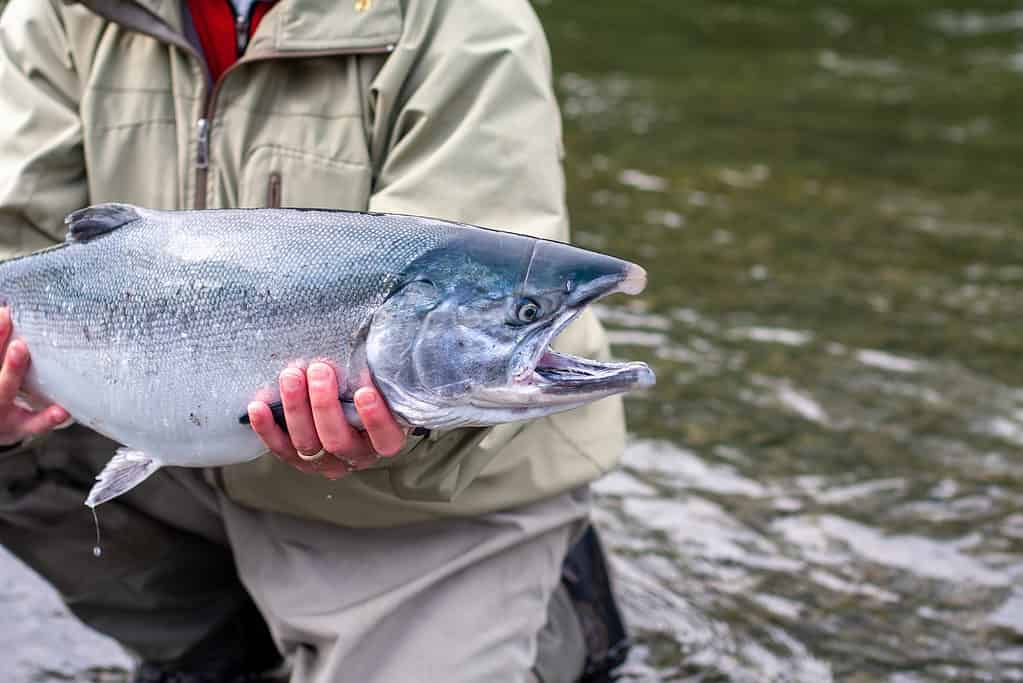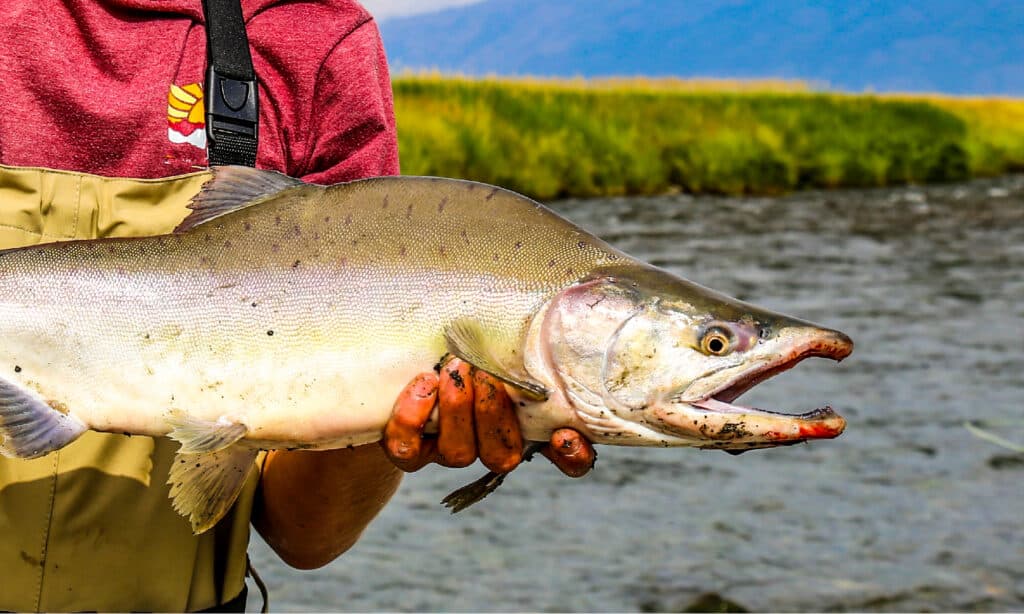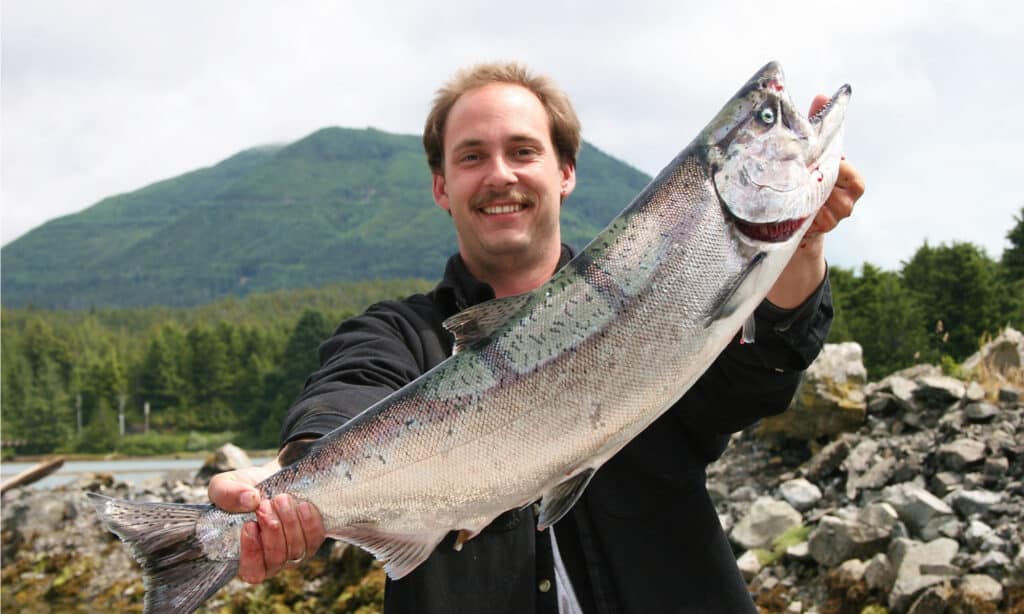Lake Michigan is an angler’s paradise. It’s home to over 150 species of fish, including salmon! The fishery for salmon in the Great Lakes began in Lake Michigan. In the Platte River, coho salmon had been effectively supplied in 1966, and chinook salmon came in 1967.
Although consumer salmon and trout fisheries have varied over the last 50 years, Lake Michigan continues to support a sizable charter fishing fleet that predominantly hunts the main four types of salmon.
Types of Salmon
If you’re planning on salmon fishing in Lake Michigan, here is what you might catch!
Atlantic Salmon

Salmon often have to swim a long way to reach their spawning location.
©Kevin Wells Photography/Shutterstock.com
Atlantic salmon, which are native to the North Atlantic Ocean, are well-known for their propensity for leaping and combat. Fly fishermen can catch fish at Torch Lake by casting their lines near the mouths of rivers where the fish are getting ready to spawn.
The St. Marys River, nevertheless, is the main location for angling for Atlantic salmon. Additionally, you can locate them in the St. Clair River and Lake Huron. Midway through the summer, the salmon start to spawn, and fly fishermen go for the fish in the river’s swift rapids.
Fishing for Atlantic salmon throughout the autumn months can be extremely rewarding. Many fishermen do this from October through December before the lake freezes.
Coho Salmon

One can find coho salmon in Alaska as well as the Midwest.
©iStock.com/christiannafzger
The Department of Natural Resources asserts that Coho salmon is the fish that actually launched the Great Lakes salmon fishery. The finest fishing seasons on the east side of Lake Michigan are early spring, late summer, and early fall.
You can catch this desirable species there during the entire year. Other well-known seasonal spots for the Coho are the Manistee River in the last week of October, the Platte River in the northern part of the state, and migratory fish taken in the St. Joseph River as late in the year as December.
The Anna River is a good place to look if you’re looking to catch Coho in the Upper Peninsula.
Pink Salmon

There are seven types of Pacific salmon.
©CSNafzger/Shutterstock.com
Pink salmon is the smallest version of the Pacific salmon. The record for the largest pink salmon caught in Michigan weighed in at a mere eight pounds! Pink salmon thrives best in the St. Marys River, Carp River, and tributaries of Lake Huron in the southeast of the Upper Peninsula.
Pink salmon typically breed approximately every two years, but enough salmon reproduce each year to cause spawning runs, with the biggest runs taking place in years with odd numbers. At the time of writing this, 2025 will be the next year with a spawning run.
Chinook Salmon

Chinook salmon can reach over 100 pounds in weight!
©Crystal Kirk/Shutterstock.com
We can’t make a list of salmon fishing without mentioning Chinook Salmon. The largest known Pacific salmon, the Chinook, has been a fixture in the Great Lakes for over 50 years. Chinook are captured in greater depths since they frequently favor cooler conditions.
Late summer marks the start of the chinooks’ upstream migration, and by the middle of August, they usually show up in large numbers. With anything weighing more than 20 pounds being regarded as a great-size fish, these fish are frequently referred to as “kings” and for a legitimate reason.
Piers on Lake Michigan, streams near the lake’s shore, or inland streams like the Tippy Dam, Pere Marquette, and St. Joseph rivers are all common places to catch Chinook in autumn.
Peak Time to Fish For Salmon
In Michigan waters, fishing for coho and Chinook salmon is most successful in the springtime and the beginning of fall. In the spring, go to the southern part of Lake Michigan, when the waters warm up quickly and there is a lot of bait available.
Coho and Chinook salmon begin to migrate to the rivers where they were supplied or born naturally around August, signaling the beginning of the fall salmon season. While fishing for salmon that are more dispersed in the lake along the Michigan shoreline is sluggish but not unachievable in the summertime, it is still doable.
How to Catch Salmon in Lake Michigan
Now that you know what you can catch and when, let’s go over the how!
Hiring a Charter

Boating at Lake St. Clair is a popular activity.
©Dave Bosen/Shutterstock.com
It is advisable to rent a charter if you are a novice to salmon fishing or are not accustomed to salmon fishing in Lake Michigan. Salmon are picky animals that react to the constantly changing water’s temperature, current, and biological ingredients, which cause them to naturally wander into and out of lakes and waterways at distinct times of every year.
The greatest opportunity to catch a fish can be provided by a knowledgeable charter captain. There will be charter fleets accessible in the majority of the ports along the Lake Michigan shoreline. It is preferable to reserve a charter early, even a year in advance if you intend to fish throughout the spring or autumn salmon runs.
Although the majority of charters will include the equipment and bait you require for the day, you will still need to bring a few things, such as an active fishing license, some snacks, and water.
Use Your Personal Boat
Many boat-owning fishermen desire to try solo salmon fishing in Lake Michigan. This is feasible, but you need to do your research because salmon fishing calls for different equipment and methods than fishing for other species.
To create a strategy, you can do some online study and consult with anglers or the Department of Natural Resources in the region where you will be traveling. Study weather trends and consider strategies that are most appropriate for the season you intend to travel.
A helpful suggestion for boaters who want to salmon fish in Lake Michigan is to reserve a charter for one day and then apply the new knowledge and skills you have acquired to use on your own vessel for the following days.
Cast From the Shore

There are several ways you can catch salmon throughout Lake Michigan.
©CSNafzger/Shutterstock.com
There are several options for shore fishing throughout the whole Lake Michigan waterfront in all four states that surround it. The best fishing suggestions can be found on the state-specific Department of Natural Resources websites, and neighborhood tackle shops can provide guidance on the best shore locations.
When the salmon runs, river mouths make excellent spots for shore fishing. Piers in the majority of boat harbors offer several opportunities for shore fishing. Although you have more mobility and the option to use numerous lines to target different depths when fishing from a boat, a lot of fishermen have luck fishing for salmon on land.
There are periods of the year when salmon linger in the slower harbor waters, making casting or spin fishing from the beach or on a pier fairly successful. Coho salmon in Michigan congregate near piers and harbors in springtime, and throughout the fall salmon run, you are able to catch enormous coho and Chinook in these locations as they migrate to the rivers.
The goal is to place the hook in the path of the salmon so they respond to it because salmon fishing in the harbor and river tends to be more of a reaction to an approach than a feeding bite. Casting heavier spoons and crankbaits from the shore are both terrific choices.
License Information For Salmon Fishing on Lake Michigan
Given that Lake Michigan is bordered by four states, it is crucial to be aware of and familiar with the salmon-fishing laws that are relevant to your stay in the state from which you will be casting your line.
You must first purchase a fishing license that is valid for the entire duration of your vacation. Residents as well as non-residents can obtain one-day or multiple-day licenses from the surrounding states.
Make sure you submit the right licensing application.
Examine the laws for salmon capture and keep restrictions next, as they differ from one state to another and may change annually. The fisheries department within each state’s Department of Natural Resources can provide information on licensing and regulations.
The photo featured at the top of this post is © FarFlungFotos/Shutterstock.com
Thank you for reading! Have some feedback for us? Contact the AZ Animals editorial team.






